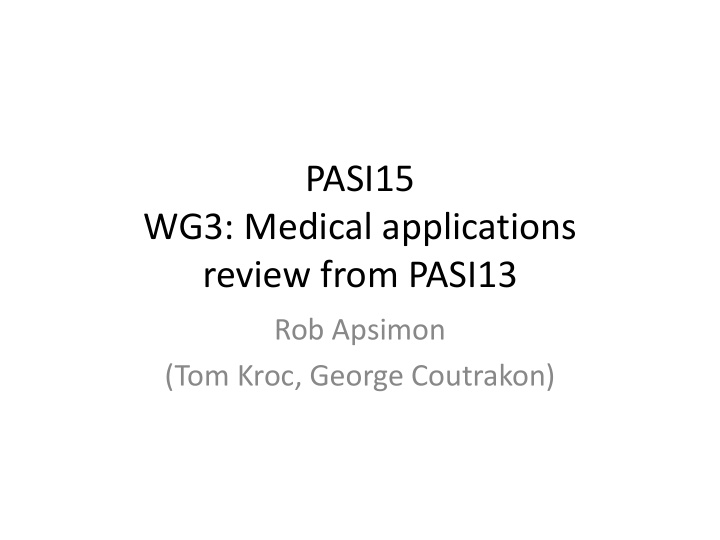



PASI15 WG3: Medical applications review from PASI13 Rob Apsimon (Tom Kroc, George Coutrakon)
General comments First PASI workshop with a dedicated medical applications working group • – Emphasis from previous workshops to focus on medical applications Apparent disparity between US and UK approaches to medical • applications – Aim to focus on areas of common interest • Attempt to establish collaborative efforts in some areas • Discuss short-term and mid-term goals for collaboration on medical applications.
Cancer stats: UK 1 in 3 deaths caused by cancer • (in 2010) 40% of cancer cures from radiotherapy • ~300 linacs for X-rays >130,000 • treatments per year 1 60 MeV eye treatment with protons • (Clatterbridge) 2 x 250 MeV Varian centres under • construction Other centres envisaged: • - IBA (Wales) • Proton therapy centres: • Christie, Manchester (in • 2018) UCLH, London (in 2019) •
Why proton therapy?
Radiotherapy stats for the UK ‘Radiotherapy Services in England 2012’, DoH 130,000 treatments, most common age around 60 yrs • 2.5 million attendances • More than half of attendances are breast/prostate • X-rays 265 linacs in clinical use • Almost all machines IMRT-enabled, 50% IGRT (Image-Guided) • Each machine does >7000 ‘attendances’ • 147 more linacs required due to increasing demand • Protons 1x Scanditronix 62 MeV, Clatterbridge, operating • 2x Varian ProBeam (3 rooms each), NHS, Christie Hospital and UCLH, 2018 • 1x ProNova SC360 (2/3 rooms), University of Oxford, 2018 • 3x IBA ProteusONE, Newport (Wales), Newcastle + ?, 2017 • 1x AVO LIGHT, London Harley Street, 2017 • Cancer care 40% curative treatments utilise radiotherapy • 16% cured by radiotherapy alone •
UK main proton therapy activities EMMA, PAMELA (completed) – FFAG demo and study • NORMA (completed) – FFAG study for protons/pCT • OMA (funded) – EU training/research on medical accelerators (www.oma-project.eu) • UK: Halo monitors, radiobiology, high-gradient acceleration, imaging calorimeters, SC gantries • collaboration with PSI, CERN, TERA, GSI etc. • Christie Research Beamline (funded) – test facility for proton medical research • Radiobiology, high-gradient linacs, dosimetry, etc. (see Karen Kirkby’s talk) • PRAVDA (funded) – Si tracker detector for pCT, includes extensive simulation • PROBE – booster linac for imaging (see my talk) • Laser-driven proton acceleration – Gabor lenses, post-acceleration, radiobiology etc. • FETS proposal – 3-20 MeV for future FFAGs, gantries, isotopes etc. • BNCT – (p,Li) neutron production for therapy, facility being upgraded •
US main medical accelerator activities Clinical • Radioisotopes • Cyclotron based systems • Therapy • Proton – growing, but concern of cost/benefit on part of insurance co’s. • Ions – none • Neutrons – one remaining, but healthy • Industry • Radioisotopes • 5 US groups working on Mo-99 • Investigating new avenues, Ac/Bi • Proton Therapy • While Loma Linda was a success clinically, it failed to commercialize the accelerator system • 16 proton therapy facilities operating in the US (one closure) • 15 more planned to open in the next 2 years • Cyclotrons are winning • US hardware providers: have at least substantial interests in 4 out of 5 (Mevion, ProTom, • Varian/Accel, ProCure/IBA) National Labs • Ion Therapy – planning, component development •
WG3 agenda Session 1 (Wednesday 16:00 – 17:30): ProBE: Proton Boosting Extension for Imaging and Therapy - Rob Apsimon Proton CT in the US - George Coutrakon Session 2 (Thursday 09:00 – 10:40): UK overview of Proton Therapy - Karen Kirkby US overview of Proton Therapy - Chris Beltran Proton Therapy - Mark Pankuch NorthStar Radioisotope Production - James Harvey Session 3 (Thursday 11:00 – 12:30) – Joint session with WG4: Laser-driven, high-brightness proton and neutron sources - Ceri Brunner Solid State Proton Acceleration - Arun Persaud NORMA FFAG - Sam Tygier Session 4 (Thursday 13:30 – 15:30) – WG3 Roundtable discussion Session 5 (Friday 09:00 – 10:40): Ion Therapy - Tom Kroc Applications of FETS - Stephen Gibson
Recommend
More recommend